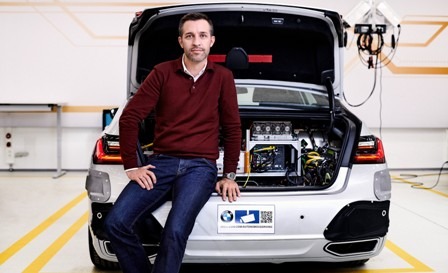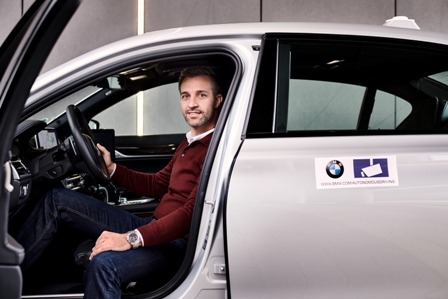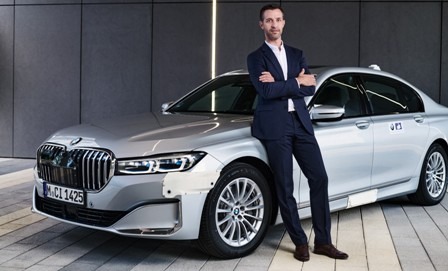Dr. Nicolai Martin is in charge of a stimulating and highly complex area of innovation at the BMW Group, namely Automated Driving Development. It is his job to deal with questions such as: what degree of automation is useful? What does the future of automation really hold for the customer? And, most importantly: what route is BMW taking to automated driving?
This interview offers intriguing insights, highlights the latest developments and outlines ideas for the future.
Dr. Martin, you are an engineer at heart. What is your driving force?
I enjoy getting to the bottom of things and understanding them. Competitive sport, namely windsurfing, all the way up to Olympic level was a genuine career option, but in the end industrial engineering and automotive engineering came out on top.
I love the sort of challenges and problems you have to really get to grips with and are complex and relevant to society at the same time. Because what I ultimately want to do is find long-lasting solutions to relevant, real-life problems and drive progress. I am fortunate enough to be working with a great team on one of the most relevant assignments for the future of automotive mobility: automated driving.
On the one hand, we actively promote the development of innovative technologies and conduct research that is virtually of academic standard. But we also carefully consider which of the potential applications we’re actually going to implement in order to offer customers worldwide genuine added value. At the end of the day, our overriding aim is to delight our customers. It’s a fascinating balance that isn’t always easy to get right.
What added value is offered by a car with automated driving capability?
Automation basically enhances comfort and safety, as the system drives the car consistently, whereas we as humans tend not to. Our customers appreciate this assistance, which eases their workload in some cases.
 For example, we have observed that drivers in Europe who have our Driving Assistant Professional system in their car are already driving with the longitudinal guidance function activated for approx. 50 per cent of the time. The figure for lateral guidance is lower, but it is still used for 30 per cent of the driving time at present (calculated from 120 million kilometres / approx. 31.35 million miles driven by our customers). That’s a lot. The conclusion we draw from this is that we have created a function that truly offers added value. In general, our systems are extremely well received worldwide and have also been shown to make driving safer already today.
For example, we have observed that drivers in Europe who have our Driving Assistant Professional system in their car are already driving with the longitudinal guidance function activated for approx. 50 per cent of the time. The figure for lateral guidance is lower, but it is still used for 30 per cent of the driving time at present (calculated from 120 million kilometres / approx. 31.35 million miles driven by our customers). That’s a lot. The conclusion we draw from this is that we have created a function that truly offers added value. In general, our systems are extremely well received worldwide and have also been shown to make driving safer already today.
What role will automated driving play in future in the context of personal mobility?
A vehicle’s intelligence will become increasingly important in future. Automation of the task of driving has an instrumental role to play here. What started out with more minor features, such as automatic control of the lighting functions, has today already progressed to assisted longitudinal and lateral vehicle control. When driving from Munich to Tuscany for a holiday, for example, not only does the system take care of switching the headlights on and off when passing through the numerous tunnels en route, it also keeps the vehicle within the speed limits and at a safe distance from vehicles ahead. If we go further and add all the possibilities offered by connectivity and the driver’s semantic knowledge, the car will turn more and more into an intelligent companion or even friend that helps and excites the driver. We are expanding on this aspect step by step.
How far has BMW progressed with automated driving?
We already have around 40 driver assistance functions in our vehicles that are rated among the best on the market. These encompass everything from the High Beam Assistant and the rear-view camera to intelligent cruise control with longitudinal and lateral guidance, complete with traffic light recognition. On the active safety side, our driver assistance systems help us to achieve the highest 5 star NCAP rating, while the top-spec Driving Assistant Professional has already won awards. In short, we are continuing to enhance our Level 2 functions.
These are almost universally available and are already of assistance or use to customers today when driving and parking. Their characteristics or availability may vary depending on local legislation. In the USA and China, for instance, we offer a “hands-off” option, which lets the driver take their hands off the steering wheel (up to 60 km/h / 37 mph), although they must continue to monitor the driving situation and remain responsible for the car. This function is deactivated (after several warning signals) if the driver is no longer paying attention.
And when will BMW begin offering Level 3 to customers?
As well as refining our driver assistance functions (Level 2), we are also working hard to ensure our vehicles are capable of highly automated driving – i.e. Level 3 – and are making very good progress here. Our automated assistance functions already perform a significant part of the driving and parking task in many situations. But the driver must still monitor the vehicle’s surroundings and is always fully responsible for how the vehicle is being driven.
We have already introduced driverless parking for vehicles in the form of the Remote Control Parking function. However, here too the driver has to monitor their vehicle and the area around it via smartphone or the vehicle key, and they are still responsible for the vehicle. This means Level 4 functionality is within reach when it comes to parking, i.e. the vehicle can look for a space and park itself in a car park, for example.
We will not offer Level 3 functionality (where responsibility passes from human to machine) in our vehicles until it is absolutely safe and offers added value. The system must react safely in extreme situations – the “corner cases” as they are known. This is what we are striving to achieve.
Does your approach differ to that of your competitors? In other words, is there a “BMW route” to automated driving?
We are developing automated driving with a clear objective: to offer our customers greater safety and comfort. The BMW Group primarily sees technology as an enabler for using automated driving and parking functions to create a positive and emotionally engaging experience for our customers. That is a clear priority for us. At the same time, technology must never take all the decision-making away from the driver. Finding the right balance between safety for everyone and added value for the individual is important to us.
In my view, BMW will in future embody the ideal blend between the world of automated driving, or “Ease” as we call it, and the pleasure of driving yourself, known simply as “Boost”. Every customer should be able to decide for themselves whether they want to take the wheel and enjoy some dynamic driving pleasure or prefer to hand over the driving task in certain stressful or joyless driving situations – such as traffic jams, stop-start traffic or parking – and use that time for something else.
In the process, a BMW will provide its driver with optimum assistance and backup at all times. I became very familiar with the two sides of the coin during one of my first jobs at the company in active driving dynamics development, when I had the chance to explore and experience their respective limits. So, it is clear to me that a BMW will consist of both dimensions in the future.
What can we expect from the all-electric BMW iX in terms of automated functions?
The BMW iX is the first model from the BMW Group to offer automated driving and parking functions based on a new technology toolkit. This toolkit will enable continuous improvement and expansion of the driver assistance functions and, in the medium term, highly automated driving (Level 3). We will continue with the rollout of the toolkit and deploy it, for example, in the next-generation BMW 7 Series and BMW 5 Series models.
In the BMW iX we are also creating real added value for customers by grouping together individual automated assistance functions intelligently and according to relevant driving situations. The new BMW Operating System 8 makes our driver assistance functions even more user-friendly. At the same time, we have reduced controls to the essentials, ensuring that the driver can activate the optimal degree of assistance quickly. Our focus here is on overall, intelligent automation, simplification of system status and intuitive operation. This simplification can be clearly seen in the reduced number of buttons on the multifunction steering wheel, for example.
 The truth is that reality – you might say complexity – has caught up with many ambitions in terms of higher levels of automation, or rather their market readiness and availability. Just because a vehicle is Level 3-capable, that certainly doesn’t mean that Level 3 automated driving is either permitted or possible everywhere. In fact, this is only currently allowed on a very small number of roads under very specific conditions. We are therefore actively deliberating when the right time would be, as we only want to offer relevant and, most importantly, completely safe functions. This means we have also scrutinised our ambitions with a critical eye and are now continuing our work intently based on a revised roadmap.
The truth is that reality – you might say complexity – has caught up with many ambitions in terms of higher levels of automation, or rather their market readiness and availability. Just because a vehicle is Level 3-capable, that certainly doesn’t mean that Level 3 automated driving is either permitted or possible everywhere. In fact, this is only currently allowed on a very small number of roads under very specific conditions. We are therefore actively deliberating when the right time would be, as we only want to offer relevant and, most importantly, completely safe functions. This means we have also scrutinised our ambitions with a critical eye and are now continuing our work intently based on a revised roadmap.
One critical issue affecting automated driving is the willingness of drivers to use the functions. How do you ensure this acceptance?
Acceptance varies greatly from region to region. We endeavour to gain customers’ trust by adapting vehicle behaviour so they recognise themselves in it. Safety always takes top priority here, so we make the system more defensive in nature, meaning that customers will never be caught off guard by overly aggressive driving. A
coherent display and operating concept is another important factor here: how do we show the customer in a clearly visible way, for example, that the sensor has detected the vehicle ahead and the function is active? In future, it might even help to deliberately make one or two of the sensors stand out instead of tending to conceal them as we do today.
But that is just one of many different aspects. As I said at the start, here we are working on one of the most exciting areas in the automotive industry.
©Copyright MOTORING WORLD INTERNATIONAL.
All rights reserved. Materials, photographs, illustrations and other digital content on this website, may not be reproduced, published, broadcast, rewritten or redistributed in whole or in part without prior written permission from Motoring World International
Contact: editor@motoringworldng.com





